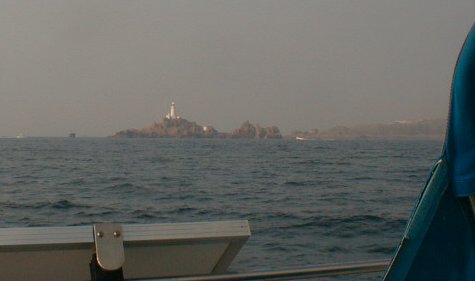

During the last leg of our second Atlantic crossing we were to suffer our first full gale at sea. One mistake nearly led to disaster.
Having received forecasts that we were to be subjected to winds up to 40 knots I began preparing the boat to cope. We had 800 miles to go to our home port in Jersey in the English Channel and this was something we were just going to have to deal with.
As the wind rose into the high 20s (Force 6 to 7) it was from the south-east. We had the jib rolled away and the normal stays'l set. We do have a storm stays'l but I decided that trying to change them in the current conditions was probably more trouble than it was worth. The stays'l could be the last sail to remain up. Although I had never tried this, we had seen squalls up to Gale 8 during the east-to-west trade-wind crossing the previous year. We had weathered these under jib alone and the stays'l has less area than the jib.
The wind was on our starboard quarter. I tried to put the second and final reef into the mains'l without altering course but the pressure against the mast was too great to pull it down so I had to round up a little for this. With the wind back behind I came back below to feel how she was coping. My trousers had got wet with spray.
 |
| Corbiere Lighthouse has stood guard at Jersey's south-west corner for centuries. I have used it as a boating landmark since childhood. It never looked better than when it appeared out of the mist after this crossing. |
The wind continued to build and Rusalka Mist began occasionally to round up in the gusts. Our speed was not excessive at between 4 and 5 knots but with the sails both out to one side of the boat, the windvane steering was not always quick or powerful enough to apply the weather-helm. Once the wind was on the beam she laid well over, the mainsail shivered and our speed shot up to over six knots. The only answer was to harness up, unbolt the hatch-boards and go out into the cockpit to heave on the tiller with both hands until she fell off the wind again.
After a few such trips, some of which took a long time at full rudder before she would come off the wind, I decided that something needed to be done. It was just getting dark on the 19th June 2000. I decided to take the main down altogether. I decided to do it next time she rounded up as this took the pressure out of the sail. I waited maybe half an hour but this did not happen. The wind and seas were still building and eventually I adjusted our course manually to free the sail enough for me to lower it and lash it to the boom.
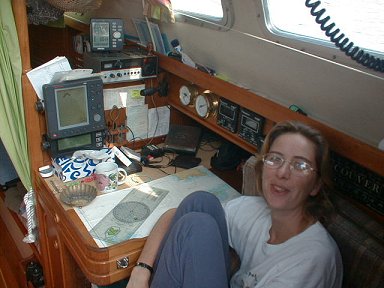 |
| With Jersey in sight, Nicky is so happy amid all the junk that has appeared on the chart table. That's Jersey in the top right corner of the folded chart, and that's St Ouen's Bay, the west coast of the island, near the top of the radar screen. |
This done I was able to set both running backstays so that the point of attachment of the stays'l stay was very well supported. Pleased with my work and with the wind back on the starboard quarter I remained in the cockpit to watch how she rode. I was peering through the companionway hatch at the GPS speed display when I heard a loud hiss behind me. I looked around and saw a vertical wall of water at least two stories high (15 - 20 feet, 5 - 6 m) coming at the stern. Nicky was moving around inside the cabin. I shouted, "Hang on to your hat!".
She wasn't wearing one, but I realised that I had a problem as I had nothing but the companionway steps in front of me, with a 5-ft (1.5 m) drop to the cabin floor. I braced both hands carefully on the sides of the hatchway and the water hit hard on my back. I watched as a wheel-barrow-full of water passed under my right arm, hit the cabin floor then bounced back up all over Nicky's bunk. I was soaked to the skin and the cockpit was full and draining. Apart from that everything was perfectly alright.
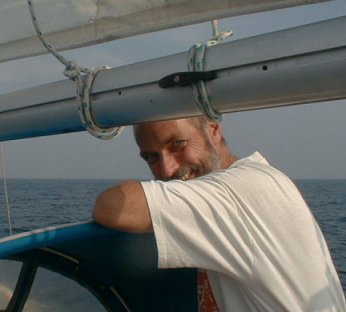 |
| Meanwhile, Nigel looks just as happy up there staring ahead. |
I quickly came below, bolted in the hatch-boards again and changed into some dry clothes. My watch had been over for more than an hour and it appeared that we would weather things well as long as we kept the boards in. I climber into my bunk behind the lee-cloth and Nicky agreed that she would wake me if our speed went over 6 knots.
She woke me at 2100 saying that there had been no problems and we appeared to be riding well. This was true throughout my watch too. Just before midnight it was time to take down the BBC forecast again before waking Nicky. Once again the Gale Warning areas included us in Finisterre. The forecast came through: "Sole, Finisterre: South veering West 5 to 6 increasing 7 to Gale 8 in North Finisterre and Sole for a time."
As I sat at the chart table and wrote, "S v W 5 - 6 inc 7 - G8 in N Fin & Sole for..." the paper began to slip under my pencil. I steadied it with the other hand and suddenly there was an almighty bang on the left side of my head and I found I was kneeling on the draining board, the other side of the boat with my head against the wooden grab-rail behind the hanging ladles, strainers and other kitchen utensils.
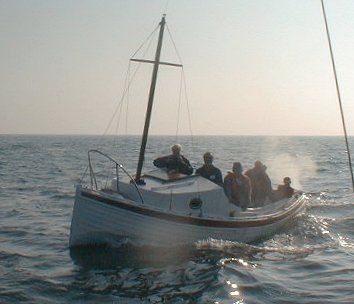 |
| Diana, a local classic restoration, brings family out to meet us as we motor in. |
In order to hold both the pencil and the paper I had not been holding on. In order to arrive on the sink we must have been knocked flat as it is a good foot (30 cm) above the seat I was on. And 5 feet (1.5 m) away.
But what about my head? It hurt like hell. As I disentangled myself from the spoons and mashers and climbed down carefully, I put my hand up to touch my head. In the dim light there was no doubt that that was blood all over my hand when I looked at it. I called Nicky from her sleep and began to get very worried that I might have damaged my skull. She looked and told me that there was a lot of blood but she could not be sure where it was all coming from.
I said I was feeling faint. She said to sit on the floor and she would get my lee-cloth tight so I could safely get into my bunk. As I lowered myself onto the hard wooden floor a familiar blackness began to close off my vision...
The next thing I remember was her extremely worried-looking face peering closely at mine. "I felt wonderful while I was asleep," I said.
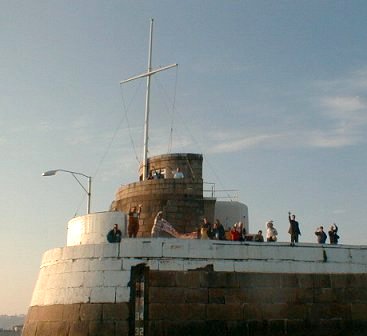 |
| Hooters, banners and waves from loved ones left behind for a year. St Helier pierhead in the evening sunshine as we motor in. |
"Watch that cooker as you get up," she said. I realised that I was flat on my back with the metal mass of the oven passing inches in front of my face as it swung on its gimbals in the rough sea. "Get into your bed. I want to check your eyes again," she added.
Apparently I had not had the peaceful repose that it had seemed to me. She was worried that I was fitting as I was jerking and writhing about under the cooker for some minutes before speaking coherently. To try to estimate the extent of my brain-damage she wanted to see if both of my pupils were the same size.
It turned out that they were, that my head was not cut or damaged but that it was the top of my ear which had split or burst open in the impact between skull and teak. She put a plaster on my ear and I went to sleep. When I woke up I felt as if I had done a day of hard, physical training with so many aches in my legs and arms. My head felt as if I had rounded it off with six or eight pints of beer and had a splitting hangover. Luckily my faculties and my brain were completely intact.
It was 0300 and my watch again. The boat described a horse-shoe or omega (Ω) -shape on the GPS plot screen that night. As the wind veered, so did our course. I did not feel like doing anything about it until daylight was established and the wind had begun to ease. The boat was at its safest with the wind on the quarter, whichever way that took us. All we did was watch the wind-speeds peak into the low 40s and watch that our speed remained sensible so that we did not start to surf. If we had, there was still the option of handing the stays'l and then eventually streaming the drogue. Sixty meters of 16 mm nylon anchor warp spliced to 20 m of 8 mm chain as well as the drogue itself were stowed in the forepeak so that we could get them ready to deploy without opening the cockpit or main hatches. The radar was still doing a better job than we could of keeping a watch for ships beyond the mountainous waves and blown spray outside.
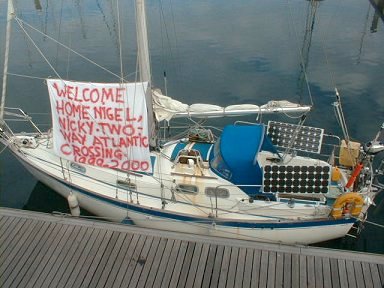 |
| We took the 'Welcome Home' banner off the wall and tied it onto the boat when we staggered home from the Chinese Restaurant that we had ended up in the first night home... It was blowing around up there |
The wind remained above 20 knots (Force 6) for the next few days. When it was slightly lower I unrolled the jib to help the stays'l, when it went back into the 30s I rolled the jib back up.
Five days later on the 24th June the wind fell back down into the teens (Force 4 - 5), the sun came out and we re-hoisted the mainsail. On the 25th the sky was so clear that we saw the green flash again at sunset. We began motorsailing to try to keep our speed up.
This lull in the wind heralded a change to the east. We now had only 150 miles to go and the easterly wind began to reach 30 knots (Force 7). We were at the mouth of the English Channel and unable to make more than a knot or so of headway towards Jersey, with or without the engine's assistance. We decided to conserve fuel and hove-to for 24 hours here, fore-reaching gently towards Brest. This was a good decision and gave us a good rest, just maintaining our radar-assisted watches.
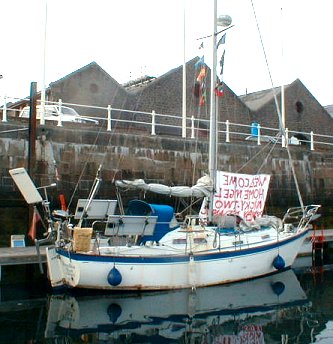 |
| We had flown the coutesy flags from each of the countries we had visited as we came in. You can see that Rusalka Mist was in need of some tlc at that point too. |
At 0400 on the 28th the east wind was light enough that we decided to drop all but the mainsail and motor straight into it for home. We kept this up for 36 hours before Corbiere lighthouse - a boating landmark on the SW tip of Jersey since childhood for me - came into view through the mist.
We had called our families with link-calls via the VHF during the afternoon. Now the mobile phone came to life and we spoke to them some more. There was a mystery unfolding in what people were saying.
As we motored along Jersey's south coast taking in the familiar sites, a little boat drifting around up ahead suddenly came to life and began heading our way. We had assumed that they were out on a fishing trip. Did they realise that they were now on a collision course?
As they drew closer, they began to wave and suddenly we recognised Nicky's father, my father, Karen and Wayne. They had come out to meet us! It was Diana, one of the small fleet of restored local classics run by the Jersey Maritime Museum and they had persuaded her skipper to bring them out and escort us in!
At 1900 on the 29th June Diana led us through the pierheads of St Helier Harbour. Suddenly a painted 'Welcome Home' banner unfurled in the evening sunlight and a cacophony of fog-horns and hooters started up on the pierhead itself. A score of people were waving. We hooted and waved back. So many family and friends had turned out to see us home!
We could not stop and enjoy this moment as we would have liked as we really wanted to get into the marina that night. With a falling tide we had only minutes to get in before the marina sill became impassable. With Jersey's huge tidal range the marina is only accessible for three hours either side of high water. Luckily someone had sent us a current copy of the local tide timetables in a mail-drop to the Caribbean months before.
Not only had the marina authorities cordoned off an excellent berth for us with plastic roadworks tape, but another huge banner had been prepared and hung from the wall above proclaiming our welcome to the world.
Once we were tied up, well hugged and some photographs taken, champagne appeared and we held a huge family re-union on the pier above the boat. Due to a miscalculation in Horta we were down to our last cigarette too, but this was soon put right.
It's lovely to go away travelling, but it can be even better to come home again!